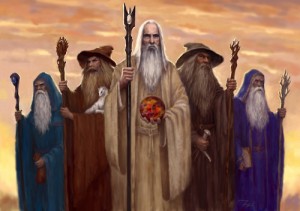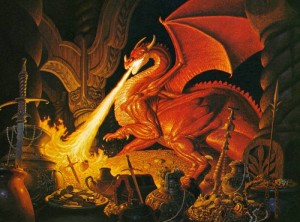This series of blogs, where I make conjectures about the plot of the upcoming The Hobbit film trilogy, is purely speculative. But if you hate spoilers, read no more, because I might just stumble upon a few of them as I Hobbit-hypothesize, as well as reveal some plot and casting nuggets that have already been dropped by Peter Jackson and his crew. To read Part 1 click here.
In Tolkien’s The Hobbit, after Bilbo, Gandalf and the Dwarves arrive at Beorn’s house, the Wizard mysteriously departs for an entire day and returns at dusk, utterly famished, whereupon he slams two loaves of bread, a pound of butter and a quart of mead and practices blowing smoke rings contemplatively at the rafters. Gandalf is vague about what he’s been up to, saying he’s gone to the The Carrock, the place where the Eagles dropped them off after rescuing them from Orcs the night before. My guess is that in Peter Jackson & Co.’s version, Gandalf will have paid a visit to Rhosgobel—the home of Radagast the Brown—which Tolkien indicated lay between The Carrock and Mirkwood Forest.
Radagast is an Istari, just like Gandalf. They are two of the five wizards who were sent to Middle-earth by the Valar (the demigods of Tolkien’s world). From the moment they were created by the Valar the angelic Istari resembled wise old men though they “aged only slowly, and they had many powers of mind and hand.” They were meant to council the inhabitants of Middle-earth (Men, Elves, Dwarves and, eventually, Hobbits) in a war against Sauron should the Dark Lord return to power. At the start of The Hobbit the five existing Istari (Gandalf the Grey, Radagast the Brown and Saruman the White as well as a pair of unnamed “blue-robed” wizards) have lived in Middle-earth for around two thousand years.
In Middle-earth Radagast’s name means “tender of beasts.” According to Tolkien’s Unfinished Tales (compiled by his son Christopher from his father’s notes) Radagast became enamored of Middle-earth’s flora and fauna and lived alone in the woods near Beorn’s homestead on the western edge of Mirkwood, forgetting his mission from the Valar to help the people of this world. He’s more like a benign Doctor Doolittle of Middle-earth than the studly Beastmaster of Mirkwood. In real life the actors who play these two wizards—Sir Ian McKellen (Gandalf) and Sylvester McCoy (Radagast)—are old friends, having most recently appeared together in a traveling stage production of King Lear with McKellen as Lear and McCoy as the Fool. It will be interesting to see if they bring shades of this production to the relationship between the dour Gandalf and the nutty Radagast.
If Peter Jackson and his writers want to make a clever visual connection to The Lord of the Rings films they could show Radagast using sentient moths as messengers, touching on the scene in The Fellowship of the Ring when Gandalf is imprisoned on the top of Orthanc, catches a moth, whispers to in a strange tongue, and then sends it off to find Gwaihir the Windlord—the giant Eagle who eventually comes to rescue him from Saruman’s lofty prison.
Close by Radagast’s home is an important site in the mythos of Middle-earth: The Gladden Fields—the place where Isildur was slain by Orcs at the start of the Third Age and where the One Ring sank to the silt in the bottom of the River Anduin. In Unfinished Tales we learn that Saruman told the White Council the One Ring was lost here and floated down the Anduin and thence into the sea. But Saruman was merely trying to throw Gandalf, Radagast and the Elves off his scent. Saruman, the craftiest of the Istari, suspects the Ring is still somewhere in the area of the Gladden Fields, and the power-hungry wizard has been searching for the all-powerful magical device for years before the action of The Hobbit begins.
What Saruman doesn’t know is that Gollum (aka Sméagol) found the Ring nearly five hundred years before and skulked off with it to the Misty Mountains where Bilbo happened upon Gollum’s “precious” after it had slipped from his finger. (Bilbo kept this wonderful treasure a secret from Gandalf.) Radagast has been living in Mirkwood almost two millennia, so he might have actually known the young Hobbit-like creature called Sméagol who used to live near the banks of the Anduin. And perhaps Radagast had heard the strange tales of the murder of Sméagol’s friend Déagol (as well as Sméagol’s sudden ability to become invisible). Radagast would certainly tell Gandalf this tale.
And maybe (still in this hypothetical film version) Radagast has found the artifact known as the Elendilmir somewhere in the Gladden Fields—a gemstone worn by Isildur and lost when he was slain by the Orcs. If Radagast did indeed find the Elendilmir, the daft wizard would probably keep the priceless artifact in an old bird’s nest or stuffed in a boot. He would show it to Gandalf—a wizard who is learned in the lore of Isildur—and Gandalf would instantly know what it was. This discovery, proof that Isildur died here, would reinforce Gandalf’s suspicions that the Dark Lord has returned to Dol Guldur to search for the One Ring in the area of the Gladden Fields.
At this point in the film Gandalf and Radagast would likely be attacked by Orcs, for Peter Jackson’s films are a wee bit action-oriented, are they not? This is the perfect opportunity for the heroic Legolas to come to the aid of the overwhelmed and outnumbered wizards. Perhaps the “young” Elf (the son of Thranduil, King of the Woodland Elves of northeastern Mirkwood) is on his way toward Dol Guldur on his own fact-finding mission in defiance of his father’s wishes. Or maybe he’s trying to find his lost love, captured by Orcs—the mysterious (and fabricated character) Tauriel played by Evangeline Lilly. Legolas and Gandalf would likely decide to partner up along with Beorn, creating a heroic trio to rival any league of superheroes: Shapeshifter, Wizard and Elven Warrior.
As an aside, I want to mention that Saruman might logically be behind an attack on Gandalf. According to Tolkien’s notes Saruman ended up with the Elendilmir gemstone and hid it in his tower of Orthanc in a secret compartment, and this would be the perfect place for him to get a hold of it. Gandalf does not suspect Saruman of treachery at this point in The Hobbit, and he doesn’t realize his fellow wizard is evil until he is made his prisoner on the top of Orthanc seventy-seven years after The Hobbit ends (see The Fellowship of the Ring, both the book and film). According to Unfinished Tales, after Aragorn becomes King, Gimli unlocks a secret chamber in Orthanc and finds two items on a shelf—a gold chain intended, no doubt, for the One Ring; and the glowing Elendilmir stone.
Gandalf returns to Beorn’s home after visiting Radagast, then leads the Dwarves and Bilbo to the western entrance to Mirkwood, leaving them to their own devices, warning them to stay on the path no matter what. (Of course they end up ignoring his sage advice.) And then Gandalf departs south for Dol Guldur with Legolas and Beorn by his side (at least in my hypothetical film version). What they find is a fortress being rebuilt and inhabited not only by Orcs, but Ringwraiths as well, including the dreaded Witch King of Angmar—Lord of the Nazgûl.
Meanwhile, Bilbo and the Dwarves make it through Mirkwood, escape from the Elven King’s realm, get to the Lonely Mountain (via Laketown) where Bilbo comes face to face with Smaug the dragon for the first time. The Hobbit: An Unexpected Journey might end with Smaug opening his evil cat-like eye, searching his dark hall for the invisible and terrified Hobbit in his midst, intercut with the cat-like Eye of Sauron opening for the first time since his downfall by Isildur’s hand, deep in the heart of Dol Guldur.
Ending the first Hobbit film at this point would be, in the action of the book, about two thirds of the way through the text. Many people might wonder, “How can Peter Jackson & Co. possibly stretch out the story for another two movies?” Get ready for the expanded role of Bard the Bowman (as played by Welsh action/throb Luke Evans) the wrath of Smaug the “Greatest of Calamities,” and Gandalf and Legolas storming Dol Guldur with a ragtag army of Elves and Men.
To be continued in Hypothetical Hobbit Plotting (Part 3)


